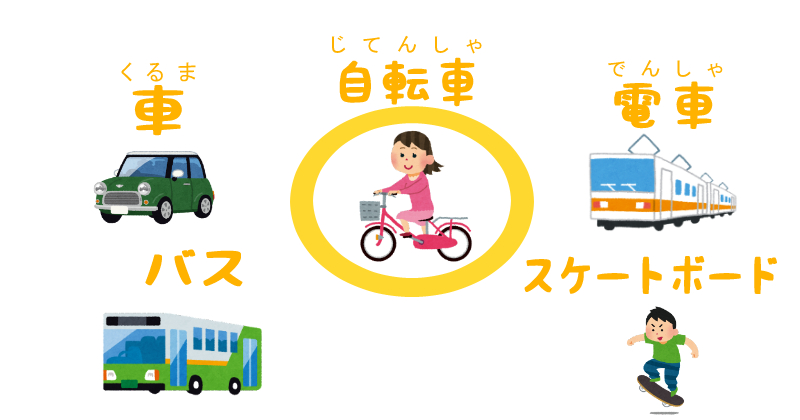Particles like で, に, を, は are some of the most difficult grammar points for Japanese learners.
Many Japanese learners in upper levels still get confused about how to use particles correctly. But you don't have to be too worried.
The key to understand particles is to grasp the concept of each particle.
Let’s understand the basic concept of で (de) and use it like a native Japanese.
で (de) particle
で (de) is one of the basic Japanese particles and is mainly used for four types of expressions.
The basic concept of the で (de) particle is “a boundary.”
It doesn’t mean that Japanese people are making boundaries in their heads every time they use a で(de) particle. But the boundary image is key to understand the で(de) particle.
The で(de) particle has four usages. One is a place, second is means and use, third is amount, and fourth is time and period. Let’s look at some examples!
場所 Place
The で(de) particle can be used for describing the place where you do something. The grammar is as follows:
grammar
Place+で(de)+verb.
Your action is done within the boundary.
For example, when you want to say “I’ll play at the park with friends,” you say 友達と公園で遊ぶ.

The park is chosen for the place of action and is in the boundary that is separate from other places.
When you say you’ll sleep in a bed, you say ベッドで寝る. Your action “sleeping” is done in a bed (boundary).
word list
友達(ともだち): friend
公園(こうえん): park
ベッド : bed
寝る(ねる): to sleep
図書館(としょかん): library
友達と公園で遊ぶ
Play at the park with friends
ベッドで寝る
Sleep in a bed
図書館で勉強する
Study in a library
point
You can't use で with the existence verb いる or ある because いる or ある express a state.
For example, you can't say ベッドでいる. It means "You are being a bed." Weird, right?
If you want to say you are in a bed, you can say ベッドにいる.
手段・方法 means and use
The second role of the で(de) particle is to describe means and use. You can specify what you use for the action. When you use the で (de) particle, the grammar is:
grammar
means+で(de)+verb.
For example, when you want to say, “I’ll go to school by bicycle,” you say 自転車で学校に行く.
The idea is that the bicycle is in the boundary that separates from other transportations, like the picture as follows.

You can also use this for speaking languages because the language is the means you are using to speak. For example, “I speak in Japanese” is 日本語で話す. The で (de) particle means that you speaking in Japanese and not any other language.
word list
自転車(じてんしゃ): bicycle
学校(がっこう): school
行く(いく): to go
日本語(にほんご): Japanese
話す(はなす): to speak
包丁(ほうちょう): knife
野菜(やさい): vegetable
切る(きる): to cut
自転車で学校に行く
I go to school by bicycle
日本語で話す
I speak in Japanese
包丁で野菜を切る
I cut vegetables with a knife
個数などの単位 the amount
The で(de) particle can be used when you specify the amount of something.
For example, there are peaches that cost 500 yen for two of them, you can say この桃は2個で500円です. The grammar is as follows:
grammar
number+で(de)+complement or verb.

word list
桃(もも): peach
500円(ごひゃくえん): 500yen
友達(ともだち): friend
部屋(へや): room
借りる(かりる): rent
会社(かいしゃ): company
始める(はじめる): start
この桃は2個で500円です。
You can buy these two peaches with 500 yen.
4人で部屋を借りる
Rent a room with four people.
3人で会社を始める
Start a company with three people
時間/期間 a period of time
The で particle can be used for describing a period of time. For example, you can say summer vacation will end three days later: あと3日で夏休みが終わる.
The boundary partitions a term in time like the picture as follows. The red line is the time of the action.
grammar
time or period+で(de)+verb.

あと3日で夏休みが終わる
Summer vacation will end in three days.
授業は5時で終わる
The class will end at 5.
point
Some people confuse で and に because you can say both 5時で終わる and 5時に終わる. (It will end at 5 o’ clock.)
The difference is that で expresses a time span. For example, your class starts at 3 o’ clock and ends at 5 o’ clock. You can use 5時で終わる because you are thinking of the time span of the class.
に expresses a point in time. You are not thinking of a time span, but rather a single point in time.
Work cited
○いちばんやさしい日本語教育入門 by 今井新悟
Easiest Introductory Japanese Teacher's manual by Shingo Imai, published in 2019

